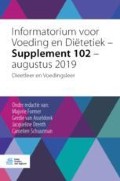Samenvatting
Een verstoring van de microbiële samenstelling van het maag-darmkanaal, de darmmicrobiota, wordt steeds vaker in verband gebracht met ziekte. Het herstellen van zo’n verstoring (een dysbiose) is daarom een veelbelovende weg om diverse ziektebeelden (deels) te herstellen. Een van de manieren om een dysbiose te verminderen is het toedienen van probiotica. Dat zijn producten met levende micro-organismen die de maag overleven en, wanneer in voldoende hoeveelheden geconsumeerd, een gezondheidsbevorderend effect kunnen bewerkstelligen. Probiotica zijn zowel in de vorm van voedingsmiddelen als medicinale producten (pillen, poeders) te verkrijgen. Toepassingsgebieden waarbij probiotica heilzaam kunnen werken, zijn diarree en het versterken van het immuunsysteem. Probiotica zijn in het algemeen veilig te noemen. Hoewel er meer grootschalige klinische onderzoeken nodig zijn om de effectiviteit ervan te bewijzen, is het gebruik van probiotica voor verscheidene indicaties veelbelovend te noemen.
Conflicts of interest: Olaf Larsen is tevens Senior Manager Science bij Yakult Nederland B.V.
Access this chapter
Tax calculation will be finalised at checkout
Purchases are for personal use only
Literatuur
Agamennone V, Krul CAM, Rijkers G, Kort R. A practical guide for probiotics applied to the case of antibiotic-associated diarrhea in the Netherlands. BMC gastroenterology. 2018;18(1):103.
Aziz N, Bonavida B. Activation of natural killer cells by probiotics. Forum on immunopathological diseases and therapeutics. 2016;7(1–2):41–55.
Van Baal MCPM. Acute pancreatitis; persisting issues from the PROPATRIA and PANTER studies. PhD Thesis. Nijmegen: Radboud UMC; 2014.
Belkaid Y, Hand TW. Role of the microbiota in immunity and inflammation. Cell. 2014;157(1):121–41.
Bermudez-Brito M, Plaza-Díaz J, Muñoz-Quezada S, Gómez-Llorente C, Gil A. Probiotic mechanisms of action. Ann Nutr Metab. 2012;61(2):160–74.
Besselink MG, Van Santvoort HC, Buskens E, Boermeester MA, Van Goor H, Timmerman HM, et al.; Dutch Acute Pancreatitis Study Group. Probiotic prophylaxis in predicted severe acute pancreatitis: a randomised, double-blind, placebo-controlled trial. The Lancet. 2008; 371(9613):651–9.
Bongaerts GP, Severijnen RS. A reassessment of the PROPATRIA study and its implications for probiotic therapy. Nat Biotechnol. 2016;34(1):55–63.
Cani PD. Gut microbiota—at the intersection of everything? Nat Rev Gastroenterol Hepatol. 2017;14(6):321–2.
Cani PD, Knauf C. How gut microbes talk to organs: the role of endocrine and nervous routes. Mol Metab. 2016;5(9):743–52.
Duranti S, Ferrario C, Van Sinderen D, Ventura M, Turroni F. Obesity and microbiota: an example of an intricate relationship. Genes Nutr. 2017;12:18. https://doi.org/10.1186/s12263-017-0566-2.
Flach J, Van der Waal MB, Van den Nieuwboer M, Claassen E, Larsen OFA. The underexposed role of food matrices in probiotic products: reviewing the relationship between carrier matrices and product parameters. Crit Rev Food Sci Nutr. 2017;58(15):2570–84.
Floch MH, Walker WA, Sanders ME, Nieuwdorp M. Recommendations for probiotic use – 2015 update: proceedings and consensus opinion. J Clin Gastroenterol. 2015;49:S69–73.
Gilbert JA. Our unique microbial identity. Genome Biol. 2015;16:97. https://doi.org/10.1186/s13059-015-0664-7.
Goldenberg JZ, Yap C, Lytvyn L, Lo CK, Beardsley J, Mertz D, Johnston BC. Probiotics for the prevention of Clostridium difficile‐associated diarrhea in adults and children. Cochrane Database Syst Rev. 2017;12:CD006095.
Hill C, Guarner F, Reid G, Gibson GR, Merenstein DJ, Pot B, et al. Expert consensus document: the international scientific association for probiotics and prebiotics consensus statement on the scope and appropriate use of the term probiotic. Nat Rev Gastroenterol Hepatol. 2014;11(8):506–14.
Larsen OFA, Van den Nieuwboer M, Koks M, Flach J, Claassen HJHMl. Probiotics for healthy ageing: Innovation barriers and opportunities for bowel habit improvement in nursing homes. Agro FOOD Industry Hi Tech. 2017;28(5):12–15.
Ouwehand AC, Invernici MM, Furlaneto FAC, Messora MR. Effectiveness of multistrain versus single-strain probiotics: current status and recommendations for the future. J Clin Gastroenterol. 2018;52(Suppl. 1):S35–40.
Quigley EMM. Microbiota-brain-gut axis and neurodegenerative diseases. Curr Neurol Neurosci Rep. 2017;17(12):94.
Rijkers GT, De Vos WM, Brummer RJ, Morelli L, Corthier G, Marteau P. Health benefits and health claims of probiotics: bridging science and marketing. Br J Nutr. 2011;106(9):1291–6.
Round JL, Mazmanian SK. The gut microbiota shapes intestinal immune responses during health and disease. Nat Rev Immunol. 2009;9(5):313–23.
Rowland I, Gibson G, Heinken A, Scott K, Swann J, Thiele I, Tuohy K. Gut microbiota functions: metabolism of nutrients and other food components. Eur J Nutr. 2018;57(1):1–24.
Sender R, Fuchs S, Milo R. Revised estimates for the number of human and bacteria cells in the body. PLoS Biol. 2016;14(8):e1002533.
Ulluwishewa D, Anderson RC, McNabb WC, Moughan PJ, Wells JM, Roy NC. Regulation of tight junction permeability by intestinal bacteria and dietary components. J Nutr. 2011;141(5):769–76.
Van den Nieuwboer M, Brummer RJ, Guarner F, Morelli L, Cabana M, Claassen E. Safety of probiotics and synbiotics in children under 18 years of age. Beneficial Microbes. 2015a;6(5):615–30.
Van den Nieuwboer M, Brummer RJ, Guarner F, Morelli L, Cabana M, Claasen E. The administration of probiotics and synbiotics in immune compromised adults: is it safe? Beneficial Microbes. 2015b;6(1):3–17.
Van den Nieuwboer M, Claassen E, Morelli L, Guarner F, Brummer RJ. Probiotic and synbiotic safety in infants under two years of age. Beneficial Microbes. 2014;5(1):45–60.
Author information
Authors and Affiliations
Editor information
Editors and Affiliations
Rights and permissions
Copyright information
© 2019 Bohn Stafleu van Loghum is een imprint van Springer Media B.V., onderdeel van Springer Nature
About this chapter
Cite this chapter
Larsen, O.F.A. (2019). Probiotica. In: Former, M., van Asseldonk, G., Drenth, J., Schuurman, C. (eds) Informatorium voor Voeding en Diëtetiek – Supplement 102 – augustus 2019. Bohn Stafleu van Loghum, Houten. https://doi.org/10.1007/978-90-368-2388-3_5
Download citation
DOI: https://doi.org/10.1007/978-90-368-2388-3_5
Published:
Publisher Name: Bohn Stafleu van Loghum, Houten
Print ISBN: 978-90-368-2387-6
Online ISBN: 978-90-368-2388-3
eBook Packages: Dutch language eBook collection

